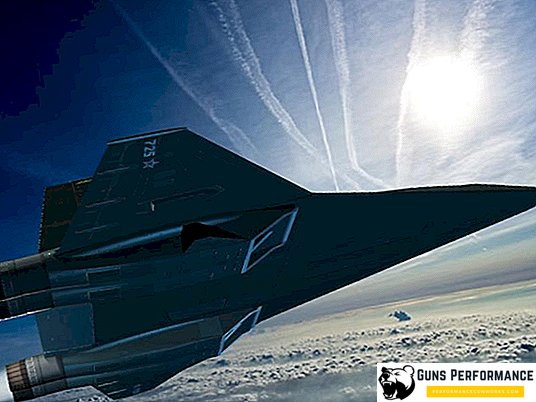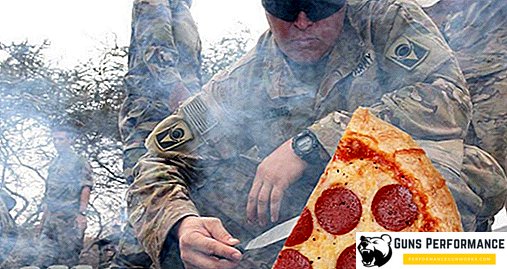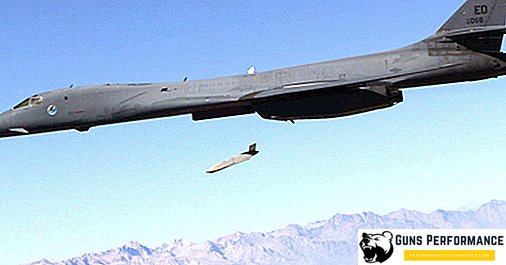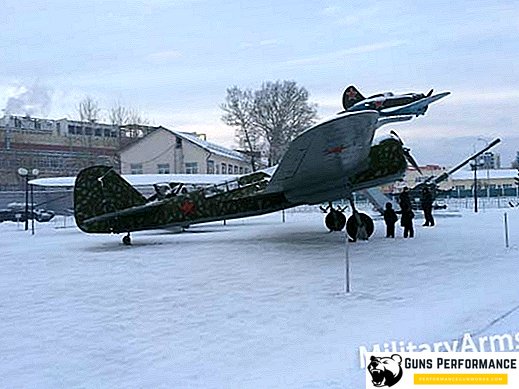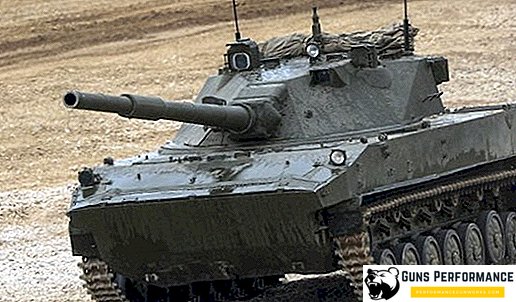
Among various types of cold arms, the saber occupies one of the leading positions. All types of sabers are characterized by a characteristic bend of the blade. Nowadays, saber fencing, dancing with sabers and simply collecting various types of sabers are very popular. The sabers are a unique type of cold arms, they were the ones who were able to hold out for the longest time as weapons of some military units.
What is a saber and how to distinguish it from the sword
Even if you have only seen a sword dance, you should be familiar with this weapon from the childhood games of the Cossacks-robbers or from films about the First World War. Indeed, the blade of the sword is difficult to confuse with any other weapon.
The saber is a slashing-cutting weapon, and many types of sabers allow stabbing. The saber handle is adapted to the grip with one hand, and the blade of the saber is on the convex side. Due to this shape of the blade, the best types of sabers are not just chopped, but also as if cutting through an obstacle that occurs in the path of the blade.

There are many types of sabers, which differ from each other in the following parameters:
- Blade length;
- The shape of the bend of the blade;
- Different shape of the handle.
Any type of saber is different from the sword by the center of gravity. In saber it is located at a considerable distance from the handle and is located between the first and second third blades (if the tip of the blade is taken as the first part). This blade balance feature makes a good saber an ideal weapon for delivering cuts with a cutting effect. Naturally, the application of this type of impact requires many hours of training on a mannequin.
Curve saber significantly increases not only the force of impact, but also the area of damage. Since the blades of sabers must have elasticity and viscosity, the manufacture of light sabers became possible only with the development of metallurgy technologies.
The main differences between the sword and the sword are:
- The total weight of the weapon (mostly sabers are lighter, since, as a rule, they were riders' weapons);
- The presence of the curvature of the blade (although there are swords with a straight blade, for example, a straight sword sword);
- The sabers are different from swords by various fencing techniques;
- Sabers are designed for one-handed grip (although the famous Japanese katana, although called a sword, is essentially a kind of saber);
- Saber blades have sharpening on one side only, while, like swords blades, as a rule, they are double-edged.
The first sabers appeared in the east of the nomadic peoples around the 6-7 century, although the first cold weapon, resembling a saber (rather a broadsword with a straight blade), was encountered already in the 5th century. The combat saber is a direct descendant of a long cavalry sword, which, as a result of evolution, first acquired a one-sided sharpening (broadsword), and then a characteristic bend of the blade (a typical eastern saber curve).

The first types of sabers had an insignificant curvature, which made it possible to apply piercing and cutting blows. From the 14th century on the saber appears elman (thickening at the end of the blade, allowing you to apply stronger and concentrated blows). A prominent representative of the saber of this period is the classic Turkish saber. Oriental sabers of that era were distinguished by the incredible quality of the blade and the beauty of the exterior finish. All the legends that were brought by the English and French knights after the crusades relate to this particular Oriental weapon (Turkish sabers). The oriental type saber curve had a curved handle, which ended with a characteristic top (although the types of handles could differ significantly from each other). A saber curve with such a blade was not intended to be stabbed.
The difference between the saber, which was used in Europe 17-17 centuries, was the lesser curvature of the blade. The hilt of the saber of that era was massive enough to reliably protect the arm from damage during fencing. The last sabers that remained in service with European troops in the 19th century were distinguished by an even lower blade curvature, which perfectly demonstrates the best blade of this period - the sword.
Variety of sabers
The evolution of sabers with a curved blade began from the time when nomadic tribes began to improve the Roman sword Spatu. It took several centuries, before the saber took the familiar look. Although in the times of ancient Egypt there were special types of cold arms that resembled sabers.

Sabers models from antiquity to the beginning of the 20th century:
- The first weapon, the curved part of the blade which remotely resembled combat sabers, was the Egyptian kopes. Most scholars attribute these ancient blades to the scimitar (saber of the janissary), although the kopes can equally well be attributed to battle sickles. Curved blade of this weapon was available only among the elite soldiers of the Egyptian army, which is explained by the complexity of manufacturing. Kopes, as a rule, was made of copper or bronze; therefore, several well-preserved copies of this weapon have survived;
- One of the first types of sabers is the Turkish scimitar. Although the scimitar became popular only in the 16th century, at first glance they can guess the advanced model of the Greek sword falcata. The hilt of the saber was made of bone, devoid of any guard. This Turkish weapon has considerable weight, and specific sharpening (concave, in the form of a "falcon wing") made it easy to cut off the head and limbs of the enemy;
- The broadsword of the 18th century heavy cavalry is considered to be the broadsword, which is a peculiar hybrid of sword and sword. The field of combat use of this weapon is extremely wide. They can be applied as stabbing and chopping. In addition, the sword has a massive hilt, which perfectly protects the hand of a warrior;
- Boarding sabers were also extremely popular in the 16-18 centuries. They were simplified models of European military sabers. The sea saber was rather short, and the developed guard well protected the arm;
- Speaking about the saber, it is impossible not to mention the sword. The checkers are the latest dlinnoblinkovym weapons, which consisted in the armament of the army until the mid-20th century.


Russian saber since Kievan Rus
On the lands of Kievan Rus saber used along with swords. If swords were dominant in the northern regions, the sabers were actively used by Russian soldiers in the southern regions, which were often attacked by steppe nomads. Of course, a sword or an ax is an excellent (and traditional) weapon of Russian knights, but in battles with light steppe cavalry, armed with swords and dressed in light leather armor, this Russian weapon was ineffective.
Already in the 9th century, the princes began to arm their squads with sabers in order to give the Russian cavalry the opportunity to fight on equal footing with the clever Steppe men. Due to the fact that these weapons were very expensive, only the princes, the governors and their guards armed themselves with sabers. Seeing the effectiveness of this weapon in clashes with steppe inhabitants, the princes of the northern lands also armed their warriors with sabers.
The sabers in Russia of 9-12 centuries were quite massive and had a curved handle. Often a lanyard was attached to it, for which a hole was provided in the handle.
Cossack sabers 15-18 centuries
The first mention of the Cossack army belong to the 15th century. The culture of the Cossacks is closely associated with weapons, especially with sabers. The Cossack saber of the 16th century was either a copy of the saber of Kievan Rus, or the Turkish saber of the "Klych" type, which were captured in military campaigns or bought from the Turks or nomadic peoples.
The best was considered to be the Shamshir Persian saber, which was often made of Damascus or damask steel. Such a saber could afford only the rich Cossacks, and they often took them in battle. Another very valuable saber was considered the so-called "Adamashka." This word refers to all crooked oriental sabers made of Damascus steel.

The saber was considered the main attribute of a free Cossack, therefore it was carefully kept and passed from generation to generation. Cossack saber combat technique was honed in constant clashes with nomads, and later polished in battles with the Polish army.
Apart from Shamshir, most of the Cossack sabers of that time were designed to deliver both chopping and stabbing blows. Most of the arms of sabers were decorated with images of animals or birds, which served as a kind of amulet for the warrior.
Polish sabers 15-18 centuries

Polish sabers began to gain popularity since the 15th century. Before that, Poland had been an ardent supporter of the use of heavy swords. Since the main enemy of the Poles - the Teutonic Order - was defeated, and firearms gained immense popularity, the use of heavy armor and swords became irrelevant.
The first who began to use sabers were representatives of the Polish gentry and warrior hussar regiments. Hussar cavalry Polish saber (which was almost a complete copy of the Hungarian) came at an opportune moment.
The Hungarian saber in the hands of the Polish gentry turned into the subject of "arrogance." Initially, this weapon was imported from Hungary, but soon it began to be made in the Polish state, having glorified the Polish arms school over time.
Hussar saber appeared in the 16th century, and widely spread in the 17th, is the heaviest Polish saber. Its feature is a massive guard, which perfectly protects the hand. Hussar saber was a multifunctional weapon, indispensable for a professional warrior.
Overview of the French Sabers of the Napoleonic Wars
The era of the Napoleonic Wars was marked by cardinal reforms in military affairs. Naturally, she touched the cold arms of the French cavalry. Those sabers, which were in the armament of the cavalry before the reform, were too curved, which made it difficult to deliver piercing blows, which in the close battle were irreplaceable.
In 1806, the light cavalry swords were replaced with new designs. Garda new sabers began to be equipped with two more protective arms on the side, which made it possible to make the hand protection more perfect.

As a result of innovations, the French saber received a new, less curved blade, which was perfectly adapted for both piercing and chopping punches. The tip was shifted from the line of the butt to increase piercing qualities. The blade itself was additionally honed near the tip of the butt.
Cutlass
A boarding saber appeared in the 16th century, when brutal naval battles became commonplace. Prior to their appearance, pirates and sailors used conventional bladed weapons, but the specifics of the sea battle required a short and strong weapon. At first, the sailors used heavy cleavers, from which the boarding sword evolved.
Since most of the pirates and sailors were ordinary people, the art of fencing was very far from them. According to the principle of action, the boarding saber resembled a simple cleaver, which was customary for former peasants and citizens. In order to learn how to own a boarding saber, it was enough to take a few lessons, since the whole combat technique was to deliver powerful blows with a wide range of motion.

Boarding saber is a short, but wide and heavy blade. Since various situations arose in a naval battle, a massive boarding saber could not only howl in arms, but also be used to cut through doors. In addition, the massive guard perfectly protected the hand of the owner and could be used as a brass knuckle.
The boarding saber could even be blunt, a wide blow combined with the weight and width of the blade still inflicted deadly wounds. Naturally, good fencers did not use boarding sabers, since they were practically not suitable for fencing.
What saber is different from checkers
In 1881, all the sabers that were in service with the Russian army were replaced with checkers. Since firearms made the armor useless, the need for heavy saber blades was eliminated, and the light sword of an armless warrior could be cut in half (as some Highlanders did). The sabers in the army remained only as an element of dress uniform.
One of the main differences between sabers and sabers is the complete absence of hand guards on the guards' savers, since the saber did not use fencing but chopped it up. If two opponents met in battle, then there was no question of parrying the blows with a sword. In battles, the Cossacks turned aside and dodged enemy strikes, choosing the right moment to deliver a quick and precise chopping blow.
To the Cossacks, the shash (which translates as a long knife) came from the Highlanders, who masterfully owned them and managed to kill the Cossack with one blow, while he took out a heavy saber.
Officer's front saber
Officer dress sabers gained popularity after the First World War. In many countries, many parade elements have appeared, the officer saber of the parade model belongs to them. Officer's ceremonial saber was very popular with the highest ranks of the Wehrmacht. In the Soviet army, instead of saber was an officer's sword.

Since the officer's saber is an element of the ceremonial costume, it carries a more decorative role. For combat qualities ceremonial saber as effective as a stupid training saber. But great importance is attached to the exterior of the handle and scabbard.
Thanks to military traditions, ceremonial sabers and checkers can be seen on military parades of many countries of the world.
Saber world championship
For the first time the World Cup (World Cup) on the saber (although the world he began to be called only from 1937) after was held in 1921 in France. The World Saber Championship was declared a European tournament, as the participants were prize-winners from various European countries.
After 1937, when the world championship on saber received the official status of the world, it began to be held every year, with the exception of the year in which the Olympic Games fell.

The first team competitions on saber were held in 1930, in essence they can be considered not only European, but also the world team championship on saber.
The saber has gone a long way of evolution, accepting various modifications depending on the conditions in which it was applied. Heavy blades were popular in Europe, where cuirass remained, and lighter blades prevailed in the east, where the saber fighter’s dexterity and skill was always placed higher than iron armor.


